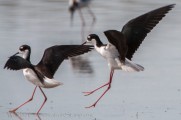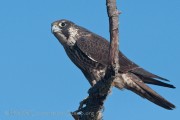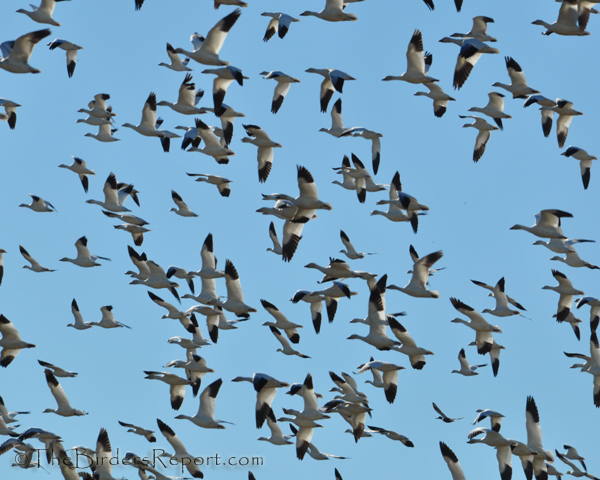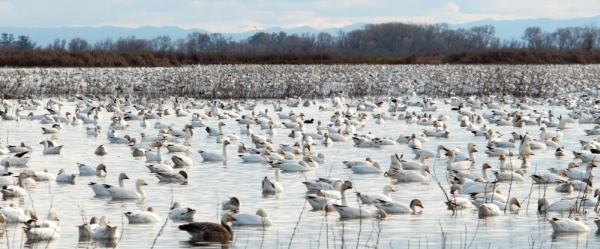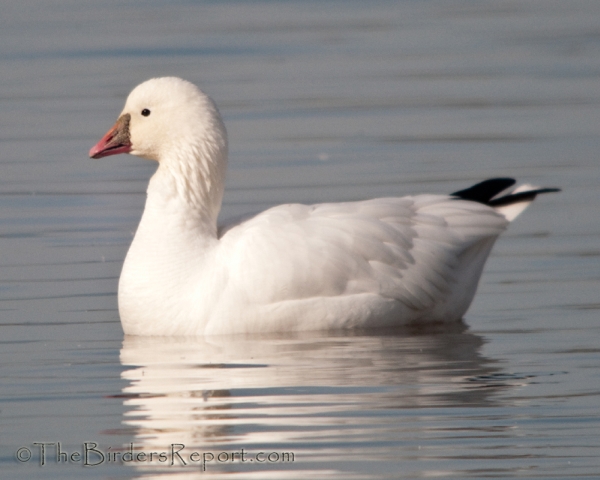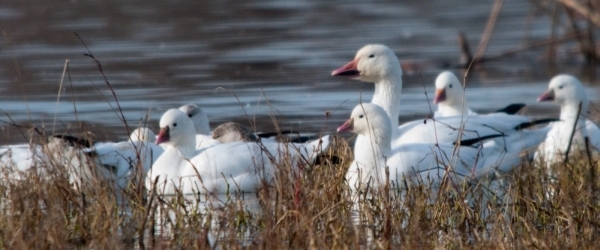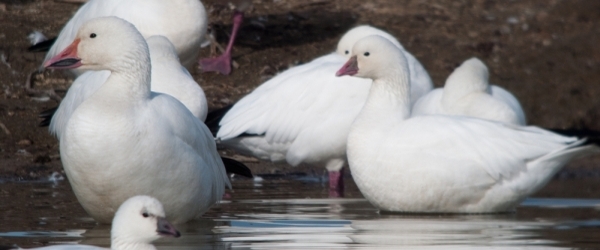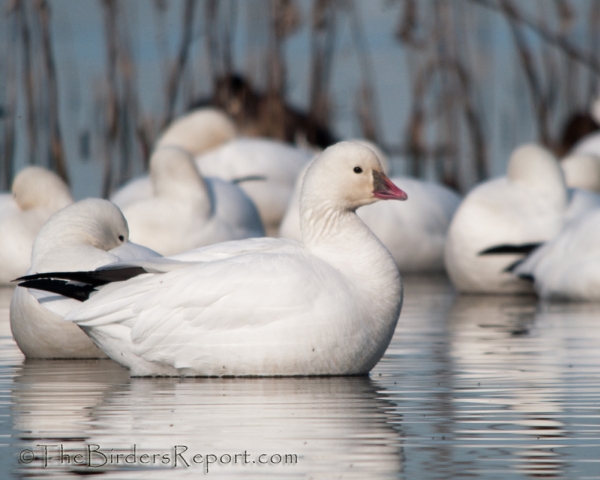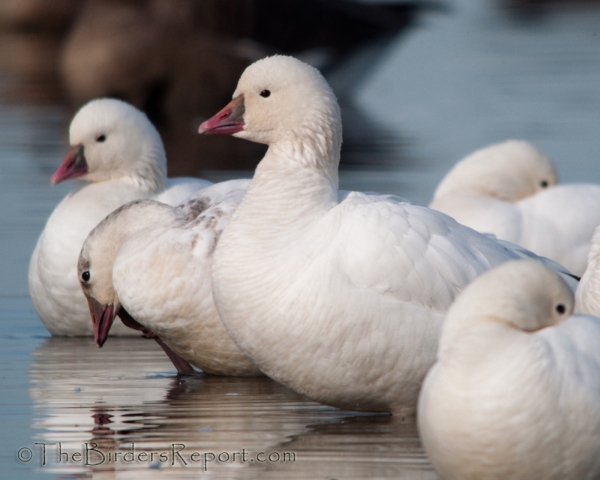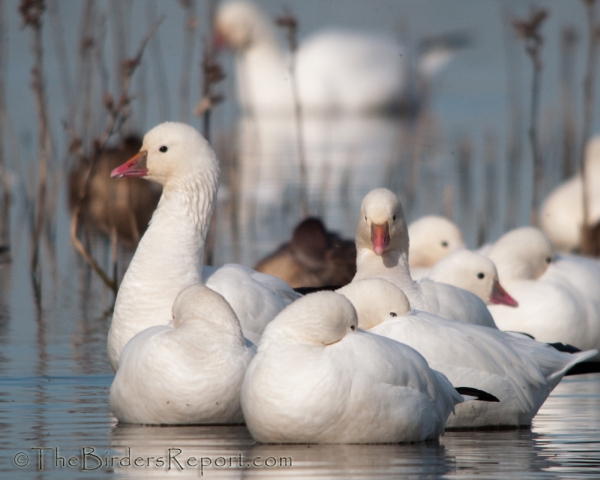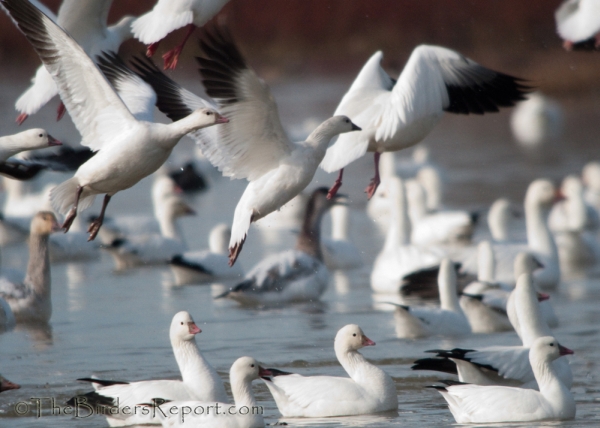The Sacramento National Wildlife Refuge is a nationally known gem and well worth the 90-mile drive. Enormous numbers of waterfowl fill the sky and numerous impoundments in fall and winter. Snow, Ross’ and Greater White-fronted Geese, Northern Pintails, Northern Shovelers and Gadwalls are assured. Possibilities are White-faced Ibis, Green-winged Teal, Black-necked Stilts and various raptors. We hope to provide 2-way radios to report sightings and alert people in other cars to look for them. Most of the birding is done from cars. Meet at the Redding Civic Auditorium to carpool. Bring a lunch for this full-day trip. Bill Oliver will lead.
Tag: Sacramento National Wildlife Refuge
BirdWords: Snow Geese Flock to Central Valley
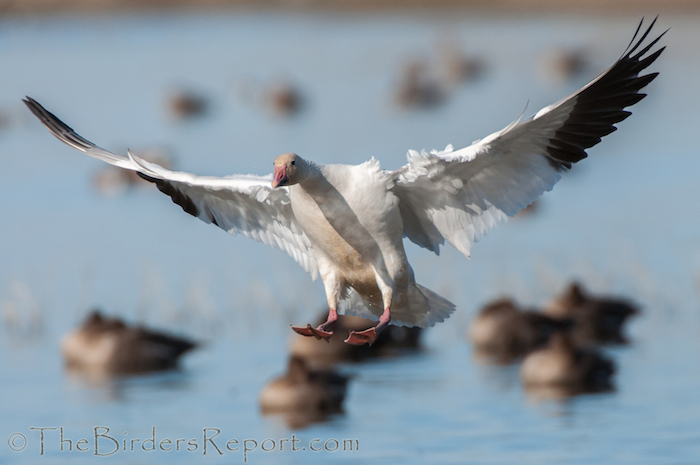
My sister is not a bird watcher, but as she and her family drove back to the Bay Area after a Redding Thanksgiving we received her text: “What’s a big white bird with black wingtips?”
After confirming that they were near Willows and that there were many of the birds we told her “snow geese.”
Small wonder that the birds grabbed her attention. Every winter hundreds of thousands of them, in squealing tornadoes in the sky and squawking blankets over fields and ponds, inundate the Central Valley after nesting in the high arctic, mostly on the islands between Alaska and Greenland.
First the arctic story. The tilt of the North Pole toward the sun in the spring and summer creates a polar season in which the sun never sets, for up to as much as six months right at the North Pole. This abundance of daylight spurs plant growth, in which the grasses, sedges and algae lock great quantities of solar energy into their cells through photosynthesis. That energy is then available to feed geese and ducks and shorebirds by the millions. The birds eat either the plants or the hordes of invertebrates that eat the plants. It’s calorie-rich season, perfect for raising hungry offspring.
Snow geese typically lay a handful of eggs in a tundra tussock, usually in late May. The eggs hatch in some 23 days. Both parents then tend to the young, which follow them about, foraging on their own within a day of hatching. The goslings grow quickly, developing the strength to migrate south in the fall.
Spring snows can disrupt nesting, but mild weather has helped our Pacific flyway geese do very well over the last 10 years. Their numbers grew 53 percent from 2012 to 2013 alone, up to nearly 1.4 million.
In the Redding area, the geese and many arctic nesters find winter habitat at refuges like the Sacramento Wildlife Refuge in Willows. While some 95 percent of original Central Valley habitat has been paved, built upon or turned into farms, the refuges and unburned rice fields help compensate. Many farmers flood their fields through the winter, providing rich grazing and resting grounds that have helped geese thrive, perhaps to record numbers.
However, our drought limits the extent of field flooding both on farms and refuges. The birds, with less water available, squeeze into wherever the water is — a crowded condition that risks spreading disease. For the snow geese, nesting success may be countered with winter die-offs.
Still, in a time when so many species are in decline, the snow geese are flourishing. They remain a sight and sound that harkens to a wilder and inspiring time, and make it well worth a visit to the refuge or at least an open eye as you drive south on Interstate 5.
Note: The Wintu Audubon Society will be conducting a trip to the Sacramento Wildlife Refuge on Jan. 24. See our calendar page for all the information.
Send your bird questions to education@wintuaudubon.org
Sacramento National Wildlife Refuge Outing
This nationally known gem is well worth the 90-mile drive. Enormous numbers of waterfowl fill the sky and numerous impoundments in fall and winter. Snow, Ross’ and Greater White-fronted Geese, Northern Pintails, Northern Shovelers and Gadwalls are assured. Possibilities are White-faced Ibis, Green-winged Teal, Black-necked Stilts and various raptors. We hope to provide 2 way radios to report sightings and alert people in other cars to look for them. Most of the birding is done from cars. Meet at the Redding Convention Center to carpool. Bring a lunch for this full day trip. Bill Oliver will lead.
Ross’s Geese at Sacramento National Wildife Refuge
Every autumn, tens of thousands of Snow Geese arrive in California’s Sacramento Valley following their long journey from the Canadian Arctic (click on photos for full sized images).
Waterfowl numbers at the Sacramento National Wildlife Refuge Complex may exceed two million by December, after the wetland areas of the Klamath Basin and other areas to the north become frozen. Snow and Ross’s Geese winter there in the tens of thousands.
Currently, about 95 percent of all Ross’s Geese nest in the Queen Maud Gulf Migratory Bird Sanctuary in the central Canadian Arctic. The main wintering area for Ross’s Goose (Chen rossii) is presently in the Central Valley of California, though increasing numbers winter in Arkansas, Louisiana, New Mexico, Texas, and the north-central highlands of Mexico1. Map courtesy of Terry Sohl at South Dakota Birds and Birding.
The Ross’s Goose is the smallest variety of the white geese that breed in North America. They look like a small Snow Goose but they have a shorter neck and a rounder head. At the base and sides of its smaller beak, the Ross’s Goose has species-specific vascular wartlike protuberances or caruncles which become more prevalent with age1 (more apparent on full sized image).
They also lack the “grinning black lips” of their larger Snow Goose cousin.
They are fairly easy to tell apart in a mixed flock by their size and the lack of the “black grin”
Their heads are usually whiter than the larger Snow Goose at winter feeding grounds, probably because their smaller bill is adapted for feeding on short blades and shoots of grasses and sedges as opposed to the roots and tubers the larger geese dig through the mud for.
The bird scratching itself in the background of this photo is a juvenile, still showing some gray feathering on its head and nape.
It looks like nap time for these Ross’s Geese…
at least until something stirs them into flight!
This is a video I shot at the refuge on December 1st, 2013.
References: 1Birds of North America Online

